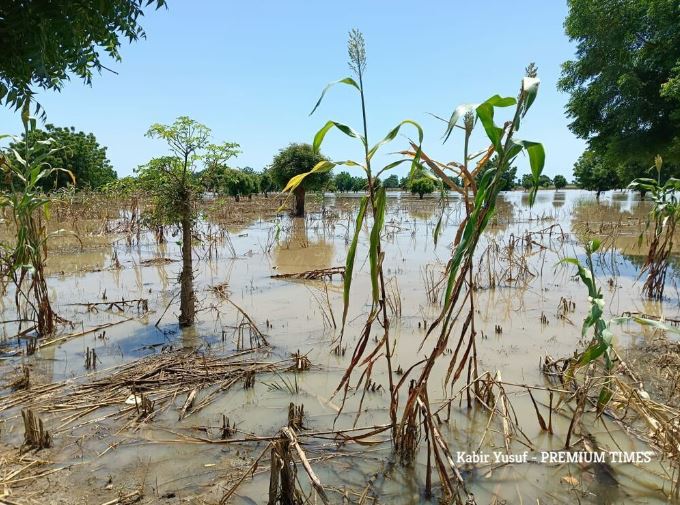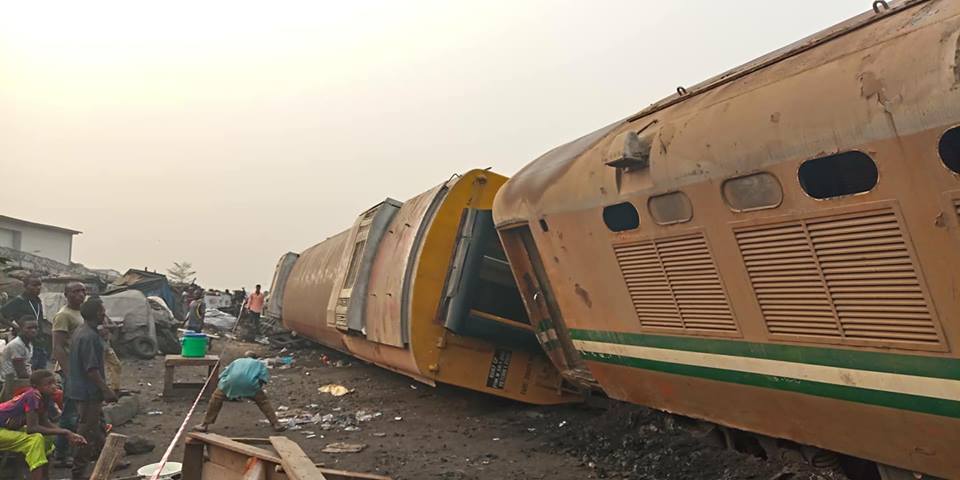“The disaster has wiped away everything,” Mr Ali said. “I was hoping to harvest over 200 sacks of rice looking at the prospect of the field …”
The view from Rabiu Ali’s farmland in Ringim, northwestern Jigawa State, used to bring him some sense of pride and security. Rolling fields of green cotton shrubs had started in early August, their white blooms offering the promise of enough income for his family to survive the year.
Now his fields, along with other vast swathes of land in Jigawa, are under green, putrid water. Last month, in one of the latest rounds of the devastating floods Nigeria currently suffers, Mr Ali’s field, as well as home, was completely submerged in Dabi, a village on the outskirts of Ringim.
“I have sent my wife and children to Kano while I am living in a friend’s house now,” Mr Ali, 37, told PREMIUM TIMES in early October.
The devastating floods have inundated hundreds of villages and urban centres including farm fields in nearly all parts of Nigeria. It is the harshest spinoff of climate change Nigeria has witnessed since the 2012 disaster.
Jigawa State is one of the worst hit states by the flood, a catastrophe that is still causing unspeakable suffering for thousands of Nigerians.
“We are facing devastating floods beyond our control,” Sani Yusuf, the head of Jigawa State Emergency Management Agency told journalists in September. “We have tried our best and we couldn’t stop it.”
Mr Yusuf didn’t respond to calls from PREMIUM TIMES seeking comments on the issue.
Since the beginning of the rainy season, which lasts from April to September in northern Nigeria and February/March to November/December in the south, the Nigerian Meteorological Agency (NiMet) and the Nigerian Hydrological Services Agency (NIHSA) predicted that flooding was imminent and that the volume of water across Nigeria would increase due to “excessive rainfalls and contributions from external flows.”
For instance, in his three different fields, Mr Ali had invested a lot of money to farm cotton, sesame, and rice which he hoped would turn in higher profits but the floodwater submerged all the fields.
“The disaster has wiped away everything,” Mr Ali said. “I was hoping to harvest over 200 sacks of rice looking at the prospect of the field in the beginning but right now, there is nothing there. Just sand filled up and the rice has been washed away.”

Even though he appears to have lost all hope, Mr Ali said he “trusts in God” and called on the government for urgent assistance.
“Any little assistance will manifest in multiples because they are not just supporting farmers but they are building back the economy,” he added.
‘Lack of respect for science’
Nigeria sees flooding every year, often as a result of inadequate infrastructure and the non-implementation of environmental guidelines. This year, authorities have blamed the floods on water overflowing from local rivers, unusual rainfalls, and the release of excess water from external forces such as the Lagdo dam in neighbouring Cameroon.
“The impact of the flooding in Nigeria is exacerbated by a lack of respect for science and leadership problems,” wrote Dakuku Peterside, a policy and leadership expert. “Our lack of respect for science and preference for superstition is at the root of the flood disaster we have at hand.”
“The flooding problem is symbolic of a country whose leadership at all levels does not value planning, working with data, and proactiveness.”
The federal government has said it is committed to reducing the impact of the flood to the barest minimum and to saving lives and property. Nigeria’s disaster management agency, NEMA, has begun the distribution of 12,000 Metric Tonnes of food and non-food items across the flood disaster hotspot.
The effort is, however, barely enough for the flooding that has created a cascade of problems, devastating the country’s agriculture, manufacturing, transportation, and public health sectors.
“The scale of devastation of the present flood situation in the country can only be compared to the 2012 floods,” said Sadiya Farouk, Nigeria’s Minister of Humanitarian Affairs, in a statement. “Over 603 lives have been lost as of October 16, 2022.”
“A total of 1,302,589 persons have been displaced and 2,504,095 persons have been affected,” the minister said.
The floods also injured 2,407 people, inundated 108,392 hectares of farmland, and “completely damaged” 82,053 homes.

These widespread cases are in 27 out of 36 States and the FCT. Nigeria’s meteorological agencies have warned that “States like Anambra, Delta, Cross River, Rivers, and Bayelsa are still at risk of experiencing floods up till the end of November.”
Troubled communities
In Gujungu, a town known for its agrarian commodity market in the northern part of Jigawa, the floodwater has effectively transformed what was once flourishing farmland into two large lakes that have engulfed entire villages and turned other lands into fragile islands.
Before the floods, all sorts of agricultural products, including grains, traditional attires, medicine, and livestock were found in the Gujungu market. It receives weekly traders from across Nigeria and also from Niger, Chad and Cameroon.
The floods have also broken a major bridge on a busy highway linking the country’s northwest and northeast. “Now that the road is inaccessible, we are forced to take another route,” said Magaji Abdullahi, a commercial driver who frequents the Gujungu-Hadejia highway.

A 45-year-old farmer named Yahaya Abdullahi and eight members of his family are among the people the flood has displaced in the state. They have been living in an uncompleted building on the roadside for over two weeks.
Mr Abdullahi said nearly everyone from his village fled when the waters rose above five feet and buildings began to collapse in Birnin Kudu, a Jigawa town near Nigeria’s northeast.
“We have been in this place for 17 days,” he said, referring to an abandoned building where they sought shelter. “This is the only place we can stay in the meantime.”
Where farmers once tilled fields of rice and wheat, wooden boats now chug across the festering pond ferrying people between towns that were saved from the brunt of the flooding and their stranded villages.

Unregulated boat transport is the only option for people in parts of the state and boat drivers said they are providing a useful service to the community: ferrying goods and passengers without giving them life jackets. Many lost their lives when the boat capsized.
Hundreds of people whose homes were destroyed have been displaced to nearby villages where they have sought shelter in schools and abandoned buildings.
“Triple Whammy”
Among the lucky few whose villages in Jigawa were not completely submerged, many have remained in their homes. Still, their living conditions are miserable. Malaria, typhoid, and waterborne diseases are rampant.
“Two of my children have been battling malaria fever,” Kamilu Mohammed, a sugarcane farmer in Jigawa’s Warbo village said, adding that “It’s like a triple whammy: battling to get shelter, food, and health.”
Like other parts of the state, farmers in Warbo village cultivated cotton fields, sugarcane, rice, millet, and wheat. A lot of the cotton and millet fields were nearly ready to harvest, residents said when one night in September, the floodwater swelled across their fields.
Emerging from their homes at dawn, they were shocked. The village was surrounded by water that stretched to the horizon. They attempted to use sacks full of sand to block water channels but their effort was barely successful.

“My mind was blank when I saw the water. I was thinking what would we do — the children were sobbing,” said one resident who identified as Bintu.
Since that day, the water had receded by about a foot, residents told PREMIUM TIMES on 1st October. But life on the village-turned-island is barely survivable. Some of the village’s wells were destroyed in the flood, so they must “drink salt-tinged water from a river they previously only used for washing clothes and dishes.”
Nearly everyone in the village is sick with malaria or typhoid, Ms Bintu noted, corroborating what Mr Mohammed had earlier said.
Gains Reversed
Up until 2015, the United Nations’ Food and Agriculture Organisation (UN FAO) said Nigeria’s rice production remained at 3.7 million metric tonnes and the country’s consumption at 6.7 million metric tonnes per annum. The federal government implemented several initiatives and programmes like the Anchor Borrowers Programme (ABP) to improve domestic supply responses in the agricultural sector.
The Central Bank of Nigeria’s (CBN) intervention funds in the agriculture space (almost N10 trillion worth of loans at single-digit rates) is effectively one of the country’s biggest subsidy schemes.
In the years that followed the launch of the ABP, the country’s local rice production jumped to about 5 million metric tonnes, a good percentage of this coming from Jigawa State. Also, the share of agricultural contribution to GDP increased to 29.9 per cent in the third quarter of 2021 from 22.9 per cent in 2014.

“The production level was self-sufficient that you hardly see foreign rice in the markets unlike the years before the ABP,” said Nura Adamu, a trader in Dutse, Jigawa’s capital. This could be due to Nigeria’s ban on rice importation and border closure at the time.
Now, the submergence of farmland is increasingly converting croplands into fragile islands. This has sparked fear of reversing the little progress that the country has made in local production.
“The prices of goods will skyrocket in the coming months as a result of the flooding,” Mr Adamu said, adding, “there will be scarcity.”
Nigeria’s food inflation has already hit a record 20.77 per cent in September 2022 from 9.20 per cent in 2015. In large part, steep rises in international food and fuel prices exacerbated by the Russian invasion of Ukraine have contributed to inflation. Both countries lie at critical junctions in the global supply chain of critical staples and inputs into fertiliser production.
Food Insecurity Imminent
Beyond Jigawa State, the flood disaster has continued to wreak havoc in several states of Nigeria, destroying farmlands growing rice, maize, and other crops. Reports of damages pouring from all parts of the country point to severe destruction of agricultural areas, prompting fears of imminent food insecurity, analysts said.
Concerns over food security were raised recently by Ms Farouk, the minister of humanitarian affairs. She wrote in a tweet that the “flood has destroyed thousands of hectares of farmland, worsening fears of a disruption of food supply in Africa’s most populous country.”
More than 500 lives have been lost, more than 1.4M persons affected, and about 90,000 homes either partially or destroyed, and still counting. Also destroyed are thousands of hectares of farmland which has worsened fears of a disruption of food supply in
— Sadiya Umar Farouq (@Sadiya_farouq) October 14, 2022
“We shall not apportion blame,” Ms Farouk added, “But communities must take climate predictions and flood outlook warnings seriously.”

Similarly, in an interview with PREMIUM TIMES, the President of the association of rice farmers in Jigawa State, Yusuf Harbo, said rice farmers in the state are the worst affected by the flood and lamented that about 95 per cent of all rice farms have been destroyed by the floods that washed them away.
“The worst affected areas include Hadejia, Ringim, Auyo, Kiri Kasamma, Jahun, and Birnin Kudu local governments,” he said.
These, Mr Harbo noted, were the areas that were producing rice on a large scale.
He predicted that the prices of foodstuff, especially rice and maize, would go up this year as a result of the disaster.
With eight years remaining to end hunger, food insecurity, and all forms of malnutrition, the world is moving in the wrong direction, the UN FAO said.
Food insecurity and malnutrition in Nigeria are well documented with Jigawa State being the state with the highest number of malnourished children. The prevalence of food insecurity increased from 11 per cent in 2016 to 19.1 per cent in 2021, UN FAO noted.
Similarly, the prevalence of undernourishment averaged 12.7 per cent in 2021 and at least 19.4 million people in Nigeria were predicted to be facing a food insecurity crisis in August, the UN FAO 2021 report on food security and nutrition noted.
“The intensification of the major drivers behind recent food insecurity and malnutrition trends (i.e. conflict, climate extremes, and economic shocks) combined with the high cost of nutritious foods and growing inequalities will continue to challenge food security and nutrition,” the UN FAO said.
Also, the World Food Programme said Nigeria and five other countries (Ethiopia, South Sudan, Yemen, Afghanistan, and Somalia) are facing a high risk of catastrophic levels of hunger.
Controlling Flooding
Nigeria’s humanitarian affairs ministry said the federal government has committed to providing relief to all communities.
“We are taking all the necessary actions to bring relief to the people affected by the flood. All relevant agencies have renewed their commitment to strengthen their efforts in reaching out to the victims and bringing relief to them,” Ms Farouk, the minister, said.
She added that the Federal Executive Council has approved “The National Emergency Flood Preparedness and Response Plans for Nigeria,” a roadmap to prevent and control flooding in the country. “This includes the immediate, short, and long-term plans.”
In September, President Muhammadu Buhari inaugurated the National Council on Climate Change to “strengthen national response to climate change and accelerate the implementation of decisive actions to reduce its impacts on the people and economy.”

“We cannot ignore what is happening in our local environment. The increasing re-occurrence of floods in several parts of the country is a wakeup call,” Mr Buhari said, lamenting the loss of lives, damage, and destruction of infrastructures such as roads, bridges, schools, and agricultural production.
Flood linked to Climate Change
Perennial flooding is one of the most prevalent natural disasters in Nigeria. Some states are increasingly experiencing annual flooding during the rainy season. Jigawa, for example, has seen flooding for nineteen years consecutively, Mr Harbo, the rice union leader, said.
This crisis owes much to one phenomenon — climate change. Increasingly, scientists have established a link between increasing flood incidences and climate change.
A study by Proceedings of the National Academy of Sciences (PNAS) found that climate change increases the probability of extreme rain events contributing to the world’s most flood damage. It concludes that as climate change increases, so too will the intensifying of extreme precipitation of events.
Aside from flooding, environmental degradation, such as desertification has been affecting agricultural productivity in the country. Jigawa and 10 other far northern states (Adamawa, Bauchi, Borno, Gombe, Kebbi, Kano, Katsina, Sokoto, Yobe, and Zamfara) are regarded as “desertification frontline” states.
Nigeria is estimated to be losing 351,000 hectares of its 70.8 million hectares of arable land to desert conditions annually with the Sahara Desert expanding southward at the rate of 0.6 KM each year, according to official records.

“The threat of climate change to sustainable livelihoods, urban and rural, is evidently real,” said Taiwo Adebayo, a PREMIUM TIMES editor and environmental sustainability enthusiast.
This newspaper had earlier reported that the 11 “desertification frontline” states constitute about one-third of Nigeria’s total land area and “greatest agricultural production belt but 50-75 per cent of their land is said to be under severe desert encroachment threat.”
To prevent desertification, the government is now creating a “wall of trees” across the frontline states under the Great Green Wall of the Sahara and the Sahel Initiative. The wall, spanning 1,500 kilometres in length and 15 kilometres wide, will cover many communities in the frontline states. A total of 225,000 hectares of land are expected to be rehabilitated under this project.
“We must get serious about investments in climate change adaptation, reducing our vulnerability, and increasing our resilience,” Mr Adebayo said.
This report was completed as part of the Centre for Journalism Innovation and Development‘s 2022 Climate Change Media Fellowship in West Africa with funding support from the Centre for Investigative Journalism’s Open Climate Reporting Initiative (OCRI).
PREMIUM TIMES






